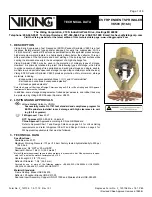
Page 6
T.A.C. 500
SYSTEM SETUP
SYSTEM SETUP
SYSTEM SETUP
SYSTEM SETUP
SYSTEM SETUP
General Programming Information:
The “Initial Setup” for the T.A.C. 500 has been
programmed at the factory. These factory default settings
may be changed to better suit your particular application.
If you decide to alter these settings, follow the
instructions below. It is important that each programming
step be taken in order. When reprogramming a specific
feature, you must always enter the programming mode
first. You may then go to the appropriate procedural steps
for the changes desired.
Note: It is recommended that you read thru all of the
following sections first, before any change is attempted.
This will familiarize you with the procedure required.
Record any programmed information you wish to change
in the spaces ( ) provided. Factory default is displayed
in brackets [ ].
(A) To Enter Program Mode Locally:
1. Press button for dialtone.
2. Enter “
✽
“ then enter the unit’s Program Code.
If the unit is new, use the preset factory code. (Factory
code is 5269). You should hear two beeps
-OR-
(B) To Enter Program Mode Remotely:
1. Call the telephone number of the unit.
2. Listen for a single tone.
3. Enter “
✽
“ then the unit’s Program Code.
If the unit is new, use the preset factory code. (Factory
code is 5269). You should hear two beeps
(C) To Run Initial Setup:
1. Unit must be in programming mode (see
above).
2. Enter “#, 0”. This tells the unit that you want to
run SETUP. No beeps will be heard.
Enter Resident Code Length:
This will be the number visible on the directory used by
a visitor to locate a resident.
Note: Resident codes may be from 1 to 4 digits in length.
All resident codes must be of the same length.
3. Enter the resident code length. 1 for one digit, 2
for two digits etc.( ) [ 3 ]
Enter Ring Count:
“Ring Count” refers to the number of incoming rings
the T.A.C. 500 will wait before it auto-answers. This
count is adjustable from 1 to 9.
4. Enter the number that indicates the number of
rings desired. ( ) [ 3 ]
For example: Enter “1” for one 5-second interval. Enter
“2” for two 5-second intervals (10 seconds). Enter “6”
for six 5-second intervals (30 seconds) etc.
Note: Nine is the maximum.
5. Enter the number of 5-second intervals
desired. ( ) [ 3 ]
Note: A “0” here will allow the output relay to engage
for a one second pulse
Enter Call Length:
“Call Length” refers to the maximum time (in minutes)
that the unit will allow a conversation to last.
6. Enter the number (1 thru 4) that corresponds to
the call length time (in minutes) that is
desired. ( ) [ 3 ]
Note: A “0” here allows indefinite call length, however
the unit will auto disconnect after 30 seconds of voice
silence.
Enter Dial Mode:
“Dial Mode” refers to the type of signal the unit uses to
dial a telephone number. The T.A.C. 500 is capable of
dialing rotary/pulse or touch-tone.
Enter “0” if touch-tone is desired.
Enter “1” for rotary.
Enter “2” for Touch-tone dialout and active
DTMF keypad after dialout.
Enter “3” for Rotary dialout and active DTMF
keypad after dialout.
7. Enter dial mode desired ( ) [ 0 ].
Note: Adding TWO to the Dial Mode selection allows
the keypad of the T.A.C. 500 to remain active for use
with voice-mail/automated attendant systems, after the
initial call is placed and answered.
Enter Latch Enable/Disable:
“Latch Enable/Disable” refers to the ability of the T.A.C.
500 to latch (hold closed) the #1 relay, from a remote
location.
Enter “ 1 “ to enable the latch feature for relay #1.
Enter” 0 “ to disable this feature.
8. Enter latch mode desired ( ) [ 0 ].
You will hear two beeps. . . .setup complete.
9. Enter “# #” to exit Program Mode, otherwise,
continue programming by entering the desired
function code.
.
Enter Gate Interval:
“Gate Interval” refers to the length of time the output
relay (parking gate, front entry, etc.) will stay engaged
after the command has been issued.
Note: Entering a ring count of '0' will cause the T.A.C.
500's speaker to emit a "ringing" sound when the
unit is called. This call may be answered by
pressing the 'start' button.
Summary of Contents for T.A.C. 500
Page 15: ...Page 15 T A C 500...
Page 16: ...Page 16 T A C 500...


































